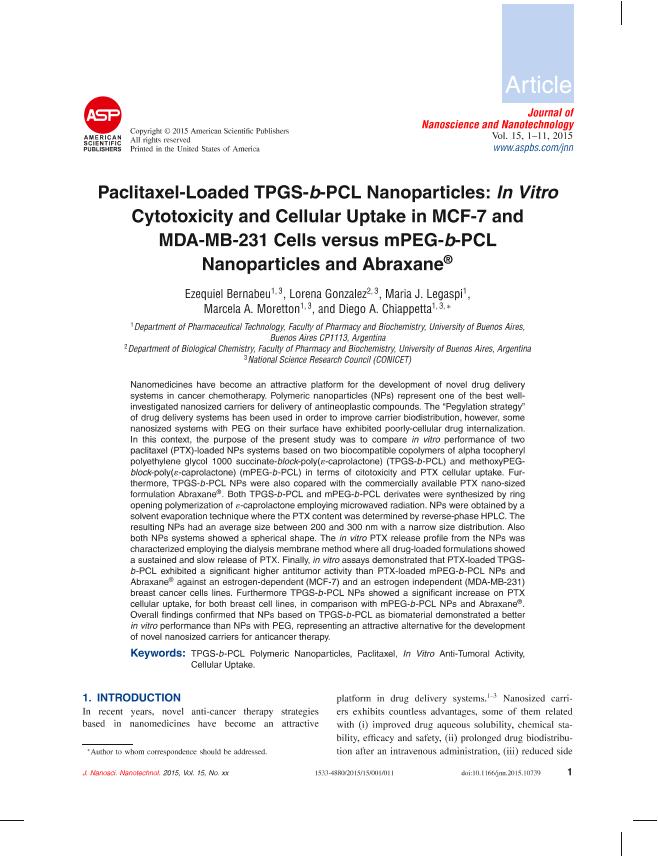Artículo
Paclitaxel-Loaded TPGS-b-PCL Nanoparticles: In Vitro Cytotoxicity and Cellular Uptake in MCF-7 and MDA-MB-231 Cells versus mPEG-b-PCL Nanoparticles and Abraxane®
Bernabeu, Ezequiel Adrian ; Gonzalez, Lorena
; Gonzalez, Lorena ; Legaspi, M. J.; Moretton, Marcela Analía
; Legaspi, M. J.; Moretton, Marcela Analía ; Chiappetta, Diego Andrés
; Chiappetta, Diego Andrés
 ; Gonzalez, Lorena
; Gonzalez, Lorena ; Legaspi, M. J.; Moretton, Marcela Analía
; Legaspi, M. J.; Moretton, Marcela Analía ; Chiappetta, Diego Andrés
; Chiappetta, Diego Andrés
Fecha de publicación:
02/2015
Editorial:
American Scientific Publishers
Revista:
Journal of Nanoscience and Nanotechnology
ISSN:
1533-4880
Idioma:
Inglés
Tipo de recurso:
Artículo publicado
Clasificación temática:
Resumen
Nanomedicines have become an attractive platform for the development of novel drug delivery systems in cancer chemotherapy. Polymeric nanoparticles (NPs) represent one of the best wellinvestigated nanosized carriers for delivery of antineoplastic compounds. The “Pegylation strategy” of drug delivery systems has been used in order to improve carrier biodistribution, however, some nanosized systems with PEG on their surface have exhibited poorly-cellular drug internalization. In this context, the purpose of the present study was to compare In Vitro performance of two paclitaxel (PTX)-loaded NPs systems based on two biocompatible copolymers of alpha tocopheryl polyethylene glycol 1000 succinate-block-poly(∈-caprolactone) (TPGS-b-PCL) and methoxyPEG-block-poly(∈-caprolactone) (mPEG-b-PCL) in terms of citotoxicity and PTX cellular uptake. Furthermore, TPGS-b-PCL NPs were also copared with the commercially available PTX nano-sized formulation Abraxane®. Both TPGS-b-PCL and mPEG-b-PCL derivates were synthesized by ring opening polymerization of ∈-caprolactone employing microwaved radiation. NPs were obtained by a solvent evaporation technique where the PTX content was determined by reverse-phase HPLC. The resulting NPs had an average size between 200 and 300 nm with a narrow size distribution. Also both NPs systems showed a spherical shape. The In Vitro PTX release profile from the NPs was characterized employing the dialysis membrane method where all drug-loaded formulations showed a sustained and slow release of PTX. Finally, In Vitro assays demonstrated that PTX-loaded TPGS-b-PCL exhibited a significant higher antitumor activity than PTX-loaded mPEG-b-PCL NPs and Abraxane® against an estrogen-dependent (MCF-7) and an estrogen independent (MDA-MB-231) breast cancer cells lines. Furthermore TPGS-b-PCL NPs showed a significant increase on PTX cellular uptake, for both breast cell lines, in comparison with mPEG-b-PCL NPs and Abraxane®. Overall findings confirmed that NPs based on TPGS-b-PCL as biomaterial demonstrated a better In Vitro performance than NPs with PEG, representing an attractive alternative for the development of novel nanosized carriers for anticancer therapy.
Palabras clave:
PACLITAXEL
,
TPGS-B-PCL NANOPARTICLES
,
IN VITRO CYTOTOXICITY
,
CELLULAR UPTAKE
Archivos asociados
Licencia
Identificadores
Colecciones
Articulos(OCA HOUSSAY)
Articulos de OFICINA DE COORDINACION ADMINISTRATIVA HOUSSAY
Articulos de OFICINA DE COORDINACION ADMINISTRATIVA HOUSSAY
Citación
Bernabeu, Ezequiel Adrian; Gonzalez, Lorena; Legaspi, M. J.; Moretton, Marcela Analía; Chiappetta, Diego Andrés; Paclitaxel-Loaded TPGS-b-PCL Nanoparticles: In Vitro Cytotoxicity and Cellular Uptake in MCF-7 and MDA-MB-231 Cells versus mPEG-b-PCL Nanoparticles and Abraxane®; American Scientific Publishers; Journal of Nanoscience and Nanotechnology; 16; 1; 2-2015; 160-170
Compartir
Altmétricas



